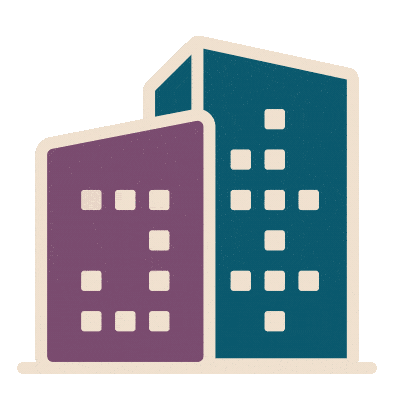Looking Back to Look Ahead: A Retrospective on COVID-19
Five takeaways shaping our present and future
The COVID-19 pandemic didn’t just challenge our systems–it fundamentally reshaped how we think about the places we spend our time. What was once an abstract concern became an urgent and pressing, inescapable reality: our built environments were no longer passive backdrops to daily life—they had become central to how we actively protect our well-being.
And today, every aspect of life has changed. Here’s 5 things we’ve learned 5 years on:
1. Making the Invisible Visible: Indoor Air Quality (IAQ) and Building Health
Because of COVID-19, everyone–from parents and school administrators to employees and facility managers–not only better understands the importance of the quality of the air we’re breathing inside our buildings, but also the outsized role clean, ventilated air can play in keeping us safe. We found that buildings could no longer be passive structures—they needed to actively protect the health of their occupants.
“The pandemic made it impossible to ignore the connection between health and the places we spend our time,” said Rachel Hodgdon, IWBI President and CEO. “This shift in public awareness has fundamentally changed how we approach building design and operations. It’s not just about meeting minimum standards for IAQ; it’s about creating spaces that proactively enhance and protect health and well-being.”
As an organization, IWBI mobilized to address the needs of the market, rapidly developing and deploying the WELL Health-Safety Rating. It provided organizations with a clear, comprehensive framework to prioritize public health and help minimize the spread of viruses. The speed and scale at which it was adopted around the world by organizations large and small and across sectors revealed the urgent need to make health a priority in our buildings, especially in times of crisis.
2. Shifts in the Way We Work
At the start of the pandemic, offices and workplaces emptied as various lockdowns began,and many workers set up home offices to do their job. Fast forward and hybrid, flexible work continues to a new norm. Surveys of office workers have shown a significant scale of the workforce has operated in some kind of hybrid scenario at some point since the pandemic started. At the same time, organizations explored innovative ways to optimize and utilize space as occupancy rates fluctuated across the U.S. and globally, making it clear that the future of where and how we work had undergone a fundamental shift.
In addition, with the enhanced awareness of public health, we’ve changed the way we look at how employees show up at work. Today, more organizations understand that the ROI of prioritizing health isn’t just about improving employee satisfaction—it’s about boosting productivity and performance, too.
3. Brain Health Moves to the Forefront
COVID exacerbated the issue of loneliness, as a risk factor for poor health. For months, and even years, we were separated from family, friends and neighbors–from our community. Social isolation, constant uncertainty, and the stress of living through a global health crisis elevated feelings of anxiety, depression and loneliness. Even when we could protect our body against a pathogen, we couldn’t completely protect our brains against loneliness. At the same time, attention to mental health as more than mental disease or cognitive function, has resulted in increased attention to brain health.
“The question is no longer how long you will live, it is how well you will live. Will your brain span keep up with your life span?,” said Dr. Whitney Austin Gray, SVP, Research, IWBI. “For many people, the pandemic put a spotlight on their own longevity, and with that came an increased attention to how to care for our mental and emotional health alongside our physical health.”
Notably, 1 in 5 U.S. adults grapple with mental illness, and the pandemic further thrust the need for solutions into the spotlight. The WELL Mind concept promotes mental health through policy, program and design strategies that seek to address varying factors that influence cognitive and emotional well-being. Today, there’s greater openness about mental health struggles, and many organizations are committed to creating more supportive environments where mental well-being is a core focus.
4. Doubling Down on the Power of Biophilia
The pandemic underscored the profound human need for our connection with nature. Confined to indoor spaces, many experienced a heightened awareness of the psychological and physiological benefits of natural elements. This led to a surge in demand for biophilic design principles in all our building types.
“WELL Certification provides strong support for the importance of biophilia, and even encourages projects to provide enhanced access to nature,” shared Jack Noonan, Vice President, APAC, IWBI. “'This emphasis on biophilic design is not just about aesthetics; it’s about creating spaces that actively contribute to the health and well-being of people inside.”
There is a wealth of research behind the benefits. The presence of plants in the workplace has been shown to reduce mental fatigue and increase productivity. Natural light, when maximized through thoughtful design, can significantly improve mood, boost Vitamin D absorption and even ward off seasonal depression. These findings underscore the importance of integrating nature into the built environment. There is true power when we bring the outside, inside–not only for our physical health but for our mental and emotional resilience.
5. Resilience Pays Dividends
The pandemic didn’t just highlight the vulnerabilities in our systems; it revealed how critical it is for both our buildings and our organizations to be ready and prepared for the unexpected. The pandemic sparked a global movement toward resilience. Businesses, schools and communities learned to pivot quickly, adjust their practices and build systems that could not only enhance health and well-being now, but also withstand future challenges.
“Resilience isn’t just about weathering the storm; it’s about how we bounce back from it and how we apply what we’ve learned to prepare for the next one,” Hodgdon noted. “Experts say that there will be another pandemic in our lifetime. Let’s keep channeling our learnings into new strategies so we stand ready to deploy our homes, workplaces, schools, hospitals and public buildings as shelter from the storm."
Moving forward, all the world is more focused on a concerted effort to ensure that every person has access to spaces that foster their well-being.







